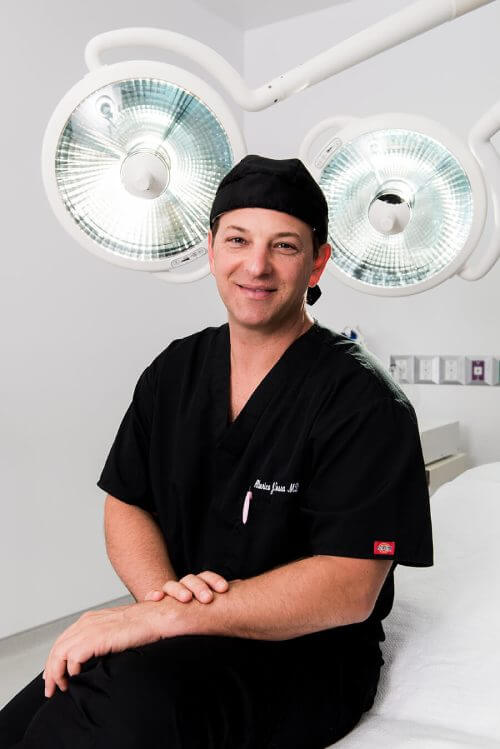There are many reasons for any woman to have breast augmentation surgery, including creating their ideal body image or as part of reconstructive surgery after a partial or full mastectomy. At Sarasota Surgical Arts, Five-Time “Top Doctors” Honoree, Dr. Alberico Sessa, transforms those goals into beautifully individualized results, guiding you through every choice from saline to silicone implants with years of experience. He also offers free, personalized consultations to help you make confident, informed decisions about your transformation.
Start your journey today: Call (941)-923-1736
Choosing the Right Implants for You
If you’ve taken one final look at your breasts and, for whatever reason, decided that change is the only way forward, then the next decision you’ll have to make is what type of breast implants you’re going to get. The vast majority of women choosing to have breast augmentation surgery in Sarasota will choose between silicone or saline breast implants, depending on many factors.
Well, it does not matter which filling you choose. Every modern breast implant starts with a soft, medical-grade silicone elastomer shell. This outer casing is biocompatible, flexible enough to move naturally with your body, and strong enough to resist rupture. Available in smooth and micro-textured finishes, the shell provides the same durable foundation for saline and silicone gel implants; only the inner contents differ.
Watch Dr. Sessa’s quick video comparing saline and silicone implants:
How Do Saline and Silicone Implants Compare at a Glance?
| Feature | Saline Implants | Silicone Implants |
| Fill Material | Sterile saltwater | Cohesive silicone gel |
| Incision Size | Typically smaller—shell inserted empty, then filled | Typically larger—implant pre-filled at factory |
| FDA Age Limit | 18 years and older | 22 years and older |
| Best rupture-detection method | Immediate breast deflation is usually obvious | Silent leaks require imaging—MRI or high-resolution ultrasound |
What Are Saline Implants and How Do They Work?
A saline breast implant contains sterile salt water and nothing else. It is empty when it is placed inside your body and filled with saline fluid when it is in place.
Because the shell goes empty, surgeons can use a notably smaller incision, meaning minimal, often nearly invisible scarring, and achieve a smoother contour when the implant is positioned beneath the chest muscle.
Newer saline models with baffled-chamber technology further improve feel by reducing the “sloshing” or rippling sometimes associated with traditional saline implants.
Read more: Saline and Silicone Implants Price
What Are Silicone Implants and What Should I Know?
A silicone implant is filled with a gel made from silicone, which is designed to feel exactly like human body fat. Silicone implants already contain this gel before they’re placed inside your body.
Newer “gummy bear” cohesive-gel implants hold their shape even if the shell is compromised, delivering a natural feel with added stability. Because silicone leaks can be “silent,” the FDA advises an MRI or high-resolution ultrasound at 5–6 years post-op and every 2–3 years thereafter to verify integrity.
Fortunately, modern manufacturing has made ruptures exceedingly rare, and the thicker gel typically remains contained should one occur.
What Are the Main Safety Concerns and Risks?
Breast implants offer great results, they still require careful consideration. Let’s discuss some risks and concerns that may arise due to the implants:
- Capsular contracture: Scar tissue hardening that can distort shape or feel and may require revision surgery.
- Infection: Usually appears within weeks after surgery; severe cases demand implant removal.
- Post-operative pain: Most of the discomfort resolves in days, but some patients report chronic soreness.
- Changes in nipple or breast sensation: Although temporary numbness or hypersensitivity is common, permanent loss is possible.
BIA-ALCL & Breast Implant Illness (BII)
- BIA-ALCL: A rare lymphoma linked mainly to textured implants, current lifetime risk estimates range from 1 in 2,207 to 1 in 86,029. Watch for persistent swelling, a lump, or pain years after surgery.
- BII: A cluster of systemic symptoms—fatigue, “brain fog,” joint pain, and more—reported with all implant types. Research is ongoing, and symptoms often improve after explanation.
What Happens When an Implant Ruptures?
Even though modern devices are durable, knowing the “what-ifs” can spare a lot of worry. FDA, in its updated report, has strengthened breast implant risk communication and help those who are considering breast implants make informed decisions.
-
Saline Implants
A valve tear or shell split lets the sterile saltwater escape, so the breast quickly loses volume and looks visibly flatter. Your body simply absorbs the fluid—no health risk—while your surgeon removes the emptied shell and, if you wish, places a new implant in the same operation.
-
Silicone Implants
Because the cohesive gel stays put, a rupture may be “silent” at first; over time you might notice pain, firmness, or a change in shape. Confirming the leak calls for MRI or high-resolution ultrasound, followed by surgical removal of the damaged implant and replacement if you choose.
How Much Do Implants Cost, and How Long Do They Last?
Most women weigh the choice between saline and silicone implants against a mix of aesthetics, surgeon advice, and budget realities.
Typical Price Range
- Saline implants: about $5,500 – $7,000, the lower end of the local $5k–$10k spectrum because the shell is filled after placement and the device itself costs less.
- Silicone implants: usually $7,000 – $9,000, reflecting higher material cost and a slightly longer operating time; several Sarasota practices list fees around $7,500–$8,500.
Figures include surgeon, anesthesia, and facility fees; your personalized quote may differ.
Longevity & Revision Expectations
- Today’s implants are built to last 10–15 years or longer, but rupture risk climbs roughly 1% per year.
- About 20% of patients need a revision within the first decade, most often for capsular contracture, rupture, or size change.
Ongoing Screening Costs (Silicone Only)
- MRI surveillance: self-pay scans in Sarasota start around $240–$300, while hospital rates can exceed $1,500.
- High-resolution ultrasound: a quicker, lower-cost alternative at $150–$450 per session.
What Should I Consider Before and After Surgery?
A few key considerations before and after surgery can make all the difference in comfort and outcome:
- Mammograms & Imaging
Ask for implant-specific mammography angles, and follow the FDA’s MRI or ultrasound schedule to monitor silicone integrity. - Future Breastfeeding & Lift Needs
Discuss how implants might affect lactation, and whether pairing augmentation with a lift now could minimize post-pregnancy sagging later. - Recovery Timeline
Plan for 5–7 days off work and avoid heavy exercise for about four weeks; light walking is encouraged to aid healing. - Sarasota-Smart Prep & Aftercare
Protect incisions from intense Gulf Coast sun, stay well-hydrated in the heat, and follow Dr. Sessa’s detailed medication and follow-up guidelines.
How Do I Choose the Right Surgeon?
The decision to have breast implants fitted is a very personal one, as is the choice of implant type. Remember: achieving a naturally beautiful look and feel depends on the skill and experience of your cosmetic surgeon. This surgery will dramatically alter your body shape, so work only with a specialist you trust 100 percent.
5 Questions to Ask During Your Consultation
- How many breast augmentations have you performed—and how many with highly cohesive “gummy-bear” implants?
- What is your overall complication and revision rate for breast augmentation?
- Can I see before-and-after photos of patients who share my body type and goals?
- Which safety protocols do you follow to minimize capsular contracture and infection?
- If complications arise, how will follow-up care and potential revisions be handled, and what are the associated costs?
Final Word
Choosing breast implants involves several steps, including selecting the right fill material, understanding long-term care, and partnering with a surgeon whose expertise aligns with your goals. By weighing costs, safety, and lifestyle considerations in advance, you can make the right choice and look forward to results that feel as natural as they appear.
Dr. Alberico Sessa provides the utmost in plastic surgery in Sarasota. Explore. our before-and-after gallery and patient reviews, then book your free personalized consultation at Sarasota Surgical Arts—call 941-923-1736 or schedule online today.






